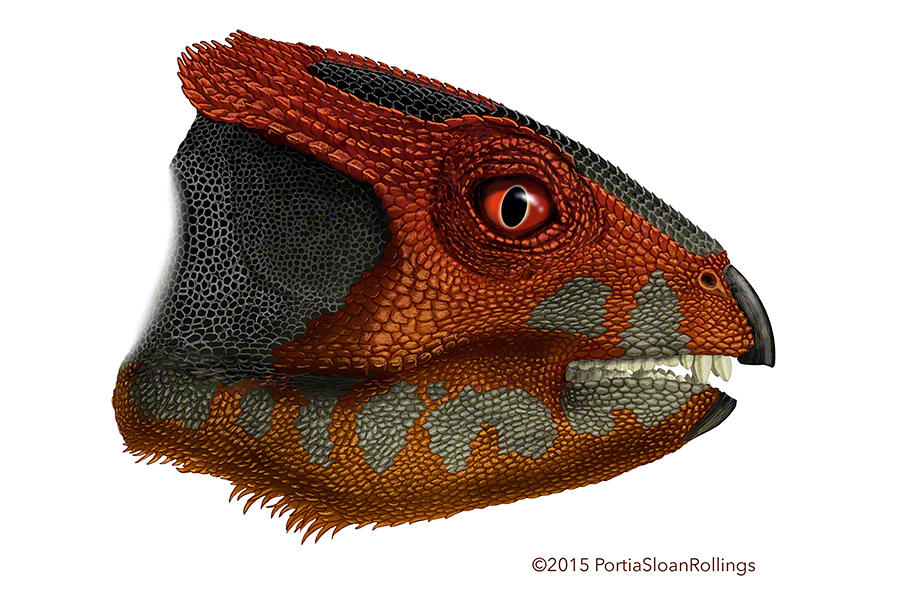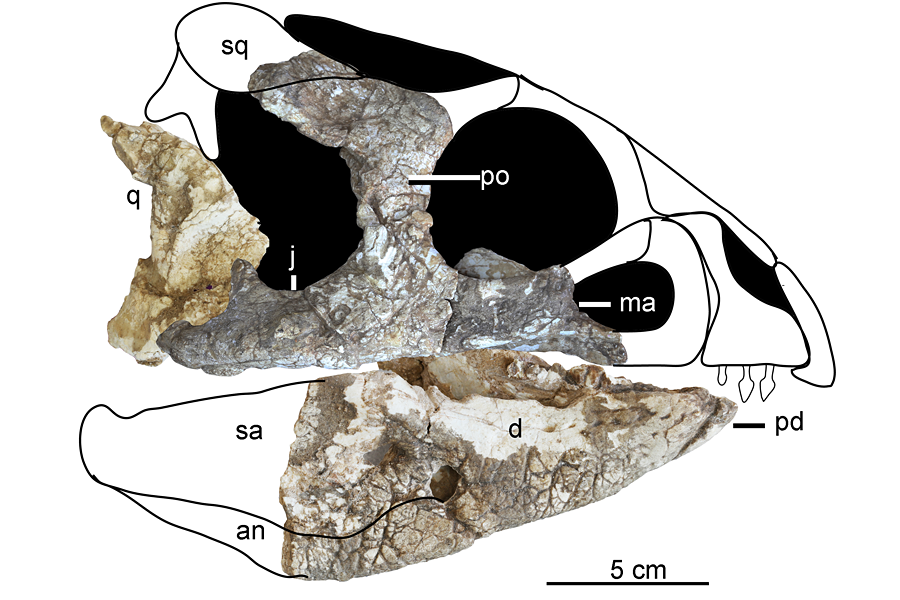Early Triceratops relative lacked horns, say scientists
Loading...
Triceratops has a new relative, many generations removed.
Millions of years before the iconic horned dinosaur roamed the Earth, its smaller cousin, Hualianceratops wucaiwanensis, lived here. And the newly discovered dinosaur could yield clues into the evolution of Triceratops and its kin.
The new species lived some 160 million years ago, positioning it as one of the first in the family of horned dinosaurs, scientists say. Already, Hualianceratops suggests that these dinosaurs were quite diverse early in their lineage.
Researchers describe the new species in a paper published Wednesday in the journal PLOS ONE.
This new dinosaur is the second Triceratops cousin found in a site dated to early in the Late Jurassic Period.
“What this new dinosaur tells us is that there was a lot of diversity in these horned dinosaurs even way back in the late Jurassic,” study co-author Catherine Forster, a paleontologist at George Washington University, tells The Christian Science Monitor in an interview.
These ancient Triceratops cousins could help scientists better understand the lineage that led to the famous, humongous horned dinosaurs.
“These little things are the humble origins of the group, a good 100 million years or so before Triceratops was around. It helps to understand the origin of one of the most familiar dinosaur groups,” University of Edinburgh paleontologist and evolutionary biologist Steve Brusatte, who was not involved in the study, tells the Monitor.
Hualianceratops belongs to the dinosaur family Ceratopsia, colloquially called “horned dinosaurs.” But Hualianceratops didn’t have any horns. The lineage was named for its later members, like the Triceratops, which did.
Ceratopsian dinosaurs lived right up until the end of the age of the dinosaurs some 65 million years ago. Triceratops didn’t appear on the scene until some 68 million years ago, leaving a significant amount of time between the new species and its well-known cousin.
Despite being so much older than Triceratops, “You can’t say this is an ancestor,” Dr. Forster says. “But it is at the base of that family tree.”
In a way Hualianceratops is like a first cousin millions of generations removed from Triceratops.
A case of mistaken identity
Hualianceratops is not the only hornless ceratopsian to be found at the base of the horned dinosaur family tree. And the specimen, pieces of the skull and a foot, was originally mistaken for this close cousin.
“It was initially thought to be a different little horned dinosaur that we found and named a few years ago,” Forster says. That dinosaur, Yinlong downsi, was by far the oldest of the dinosaur family ever to be found, until now.
Both ceratopsian dinosaurs lived around the same time and were likely close cousins, so it’s not a surprise that the Hualianceratops fossils were misclassified.
After being found at the same site as Yinlong in Xinjiang Province, China, the Hualianceratops specimen was already in a museum, labeled as Yinlong.
Study lead author Fenglu Han’s PhD research was to describe the skull of Yinlong. “In order to do that, he went to every single piece in the collection that was labeled Yinlong or probably Yinlong,” Forster recounts. “He found this one specimen that was different, that he recognized was different because he knew Yinlong so well.” Upon closer examination Dr. Han realized he was looking at an entirely different species.
The clues were in the cheek and bottom jaw bones.
The cheek bone in both animals splits in the back, explains Forster. It was the way that this specimen’s cheek bone splits that was distinct from Yinlong. The bottom jaw bone in Hualianceratops was also thicker, more heavily constructed than in Yinlong.
Hualianceratops is also uniquely textured. On the surface of its skull bones there are “a lot of little bumps and nodes and little grooves that give it a texture,” Forster says. It’s this deep sculpturing that gives Hualianceratops its name, which means ornamented face.
What did Hualianceratops look like?
This new dinosaur species would have been dwarfed by its famous cousins had they lived at the same time. While Triceratops could grow as long as two small cars end-to-end, the spaniel-sized Hualianceratops might have been able to run around its legs.
Both animals were plant-eaters, but wouldn’t have looked very much alike.
Hualianceratops did have a neck frill like Triceratops, but it was quite short. The basal ceratopsian dinosaur also walked on its two hind legs while Triceratops ambled on all fours. “It’s only later, when these animals start to get really big and their heads start getting really big, that they became quadrupedal,” Forster says.
The early “horned dinosaurs” already had the oversized heads characteristic of Triceratops. Over time those heads grew and grew, and the frills got bigger and bigger. Later along the lineage animals start to have little knobs that would later turn into horns, but none of the earliest ceratopisian dinosaurs have been found with horns.
“There’s a lot of sort of foreshadowing of what’s going to happen in the future, but not with horns,” Forster says. “The horns really don’t show up until later in the evolution of the group.”
Surprising diversity early in the lineage
“Yinlong was a surprise when we found it, this really early horned dinosaur. That was just really a neat discovery,” Forster says. “It took me a while to accept the fact that there was another one.”
But it made sense, she says. “Diversity has to be somewhere.” The scientists know there are parts of dinosaur lineages yet to be found based on whats known about the relationships between the ancient animals. Hualianceratops helps fill those gaps.
Dr. Brusatte suggests that, taking Yinlong and Hualianceratops together, these most primitive members of Ceratopsia could help pose and answer more questions about the lineage of the horned dinosaurs.
“This is a glimpse of where Triceratops came from,” he says. “They were nothing like the huge ones that came later.”
“Triceratops and those familiar dinosaurs would have had a long evolutionary history,” Brusatte says. “And they would’ve gotten their start as these fairly small second- or third-tier plant eaters.”







